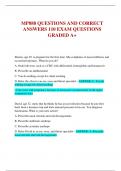MP888 QUESTIONS AND CORRECT
ANSWERS 110 EXAM QUESTIONS
GRADED A+
Sharon, age 29, is pregnant for the first time. She complains of nasal stuffiness and
occasional epistaxis. What do you do?
A. Order lab tests, such as a CBC with differential, hemoglobin and hematocrit
B. Prescribe an antihistamine
C. You do nothing except for client teaching
D. Refer the client to an ear, nose and throat specialist - ANSWER- C. You do
nothing except for client teaching
- Can occur with pregnancy because of increased vascularization in the upper
respiratory tract
David, age 32, states that he thinks he has an ear infection because he just flew
back from a business trip and feels unusual pressure in his ear. You diagnose
barotrauma. What is your next action?
A. Prescribe nasal steroids and oral decongestants
B. Prescribe antibiotic eardrops
C. Prescribe systemic eardrops
D. Refer David to an ear, nose, and throat specialist - ANSWER- A. Prescribe
nasal steroids and oral decongestants
,A sexual history of oral-genital contact in a client presenting with pharyngitis is
significant when which of the following organisms is suspected?
A. Escherichia coli
B. Haemophilus influenzae
C. Neisseria gonorrhoeae
D. Streptococcus pneumoniae - ANSWER- C. Neisseria gonorrhoeae
- Neisseria gonorrhoeae pharyngitis is a common sexually transmitted disease
The most common cause of sensoineural hearing loss is
A. Trauma
B. Tympanic membrane sclerosis and scarring
C. Otosclerosis
D. Presbycusis - ANSWER- D. Presbycusis
How do you describe the cervical lymphadenopathy associated with asymptomatic
HIV infection?
A. Movable, discrete, soft, and nontender lymph nodes
B. Enlarged, warm, tender, firm, but freely movable lymph nodes
C. Hard, unilateral, nontender, and fixed lymph nodes
D. Firm but not hard, nontender, and mobile lymph nodes - ANSWER- D. Firm
but not hard, nontender, and mobile lymph nodes
You diagnose acute epiglottitis in Sally, age 5, and immediately send her to the
local emergeny room. Which of the following symptoms would indicate that an
airway obstruction is imminent?
A. Reddened face
B. Screaming
,C. Grabbing her throat
D. Stridor - ANSWER- D. Stridor
Purulent matter in the anterior chamber of the eye is called
A. Hyphema
B. Hypopyon
C. Anisocoria
D. Pterygium - ANSWER- B. Hypopyon
A 42 year old stockbroker comes to your office for evaluation of a pulsating
headache over the left temporal region and he rates the pain as an 8 on a scale of 1-
10. The pain has been constant for the past several hours and is accompanied by
nausea and sensitivity to light. He has had frequent headaches for many years but
not as severe and they are usually relieved by over the counter medicines. He is
unclear as to a precipitating event but notes that he has had visual disturbances
before each headache and has been under a lot of stress in his job. Based on this
description, what is the most likely diagnosis of this type of headaache?
A. Tension
B. Migraine
C. Cluster
D. Temporal arteritis - ANSWER- B. Migraine
The trachea deviates toward the affected side in all of the following except
A. Aortic aneurysm
B. Unilateral thyroid lobe enlargement
C. Large atelectasis
D. Pneumothorax - ANSWER- C. Large atelectasis
, Matthew, age 52, has allergic rhinitis and would like some medicine to relieve his
symptoms. He is taking cimetidine (Tagamet) for gastroesophageal reflux disease.
Which medication would you not order?
A. A first-generation antihistamine
B. A second-generation antihistamine
C. A decongestant
D. A topical nasal corticosteroid - ANSWER- B. A second-generation
antihistamine
Jessica, an 8 year old third grader is broght to the office by her grandmother, who
is the child's babysitter. She has complained of fever and sore throat for the past 2
days. Five other children in her class have been sick with sore throats. She denies
difficulty swallowing and has been drinking fluids but has no appetite. ROS
reveals that she has clear nasal drainage, hoarseness, and nonproductive cough.
She denies vomiting but has had mild diarrhea. On examination she has a
temperature of 101.5 F, 3+ erythematous tonsils, and palpable, tender cervical
lymph nodes. Based on these findings, what is the most likely diagnosis?
A. Mono
B. Sinusitis
C. Strep pharyingitis
D. Viral pharyngitis - ANSWER- D. Viral pharyngitis
Marcia, age 4, is brought into the office by her mother. She has a sore throat,
difficulty swallowing, copious oral secretions, respiratory difficulty, stridor, and a
temperature of 102 F but no pharyngeal erythema or cough. What do you suspect?
A. Epiglottitis
B. Group A beta-hemolytic streptococcal infection pharyngitis
C. Tonsillitis
D. Diphtheria - ANSWER- A. Epiglottitis




